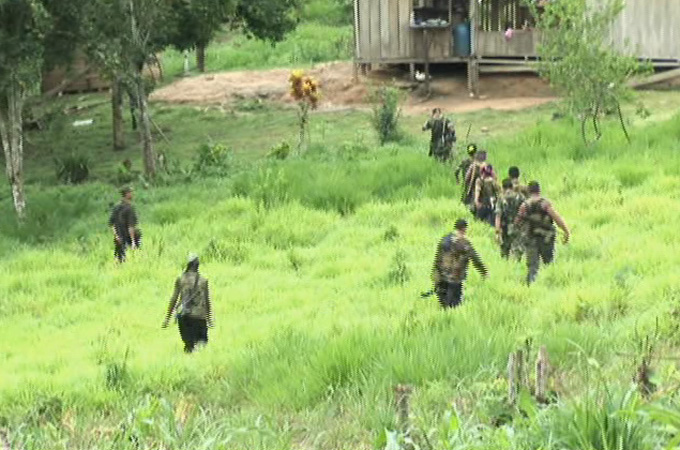Colombians protest against FARC violence
Tens of thousands of demonstrators take to the streets of Bogota to voice their anger against decades of rebel violence.

 |
| More than a decade of US-backed strikes against the FARC have severely weakened the rebels [Al Jazeera] |
Tens of thousands of Colombians outraged by the execution of four captives by the Revolutionary Armed Forces of Colombia (FARC), have staged protests across the nation to demand an end to half a century of rebel violence and kidnapping.
Juan Manuel Santos, the president, who supported the march, is facing increased pressure from Colombians to seek an end to the conflict that has left tens of thousands of dead over the decades.
Demonstrators dressed in white marched toward the main square in the capital Bogota on Tuesday, holding images of recently murdered hostages and chanting “No more war! Yes to life, yes to peace.”
According to the government, the victims – members of the armed forces held in jungle camps for more than a decade – were shot at point blank range by FARC, Colombia’s largest rebel group, as troops attacked the rebels’ hideout last month.
Their bodies were found alongside the metal chains used to tie their necks to trees.
“We have tolerated the FARC enough,” said Ruben Castano, an engineer, who took the day off work to participate. “Santos, it’s time to end this.”
Plea for peace
The FARC was founded in 1964, when it declared its aim to to overthrow the government through through an armed struggle and create a Marxist state.
Responsible for some of the harshest blows against the group, including killing its leader Alfonso Cano last month, Santos has expressed willing to hold peace talks if the left-wing rebels stop kidnapping, lay down their weapons and cease attacks on civilians and the military.
|
“It’s not just the government calling for peace, it’s all of Colombia … The people are sick of violence“ – Juan Manuel Santos, |
While the FARC has refused, Cano had hinted before his death that dialogue was the only way forward.
“It’s not just the government calling for peace, it’s all of Colombia,” Santos said at the start of the demonstration. “The people are sick of violence.”
More than a decade of US-backed strikes against the FARC has severely weakened the rebels and limited their ability to launch attacks on the nation’s economic infrastructure, attracting billions of dollars in foreign investment.
But the group remains a formidable part of the conflict, which strips as much as one per cent from the economy each year.
Once considered almost invincible – none of its seven-member secretariat was killed or captured in more than four decades – five have now died since 2008.
‘Loved ones’
The FARC, considered a terrorist group by the US and Europe, still holds 11 members of the armed forces in its camps and as many as 300 civilians.
| FARC executed four captive members of the Colombian security forces in a botched attempt to rescue the men |
“I am calling on the FARC to give us back our loved ones,” said Esperanza Rojas, whose husband, a military sergeant went missing 19 years ago. “We want a peace process.”
Armed with modern weapons and financed by drug funds and extortion, the 8,000-strong group has battled a dozen administrations since 1964.
It was created by Manuel Marulanda, a highway inspector, who fled into the mountains with a handful of peasant supporters to fight a bloody civil war known as La Violencia.
At its strongest, the FARC’s 20,000 fighters controlled much of rural Colombia, promising social justice while it attacked towns, controlled the production of coca – used to make cocaine – and threatened local government officials.
Prison camps
Many believe the FARC leadership would rather die in the jungles than relinquish the power they wield over an increasingly adolescent fighting force to serve jail time.
Santos is seeking a constitutional reform that may create a way for the FARC’s secretariat to face shorter sentences if peace is reached and they confess their crimes and compensate their victims. The last peace effort ended in shambles.
Andres Pastrana, Colombia’s former president, ceded the FARC a safe haven in 1998, the size of Switzerland, to promote talks.
But the rebels took advantage of the military absence to train fighters, build more than 25 airstrips to fly drug shipments, and established prison camps to hold its hostages.
Efforts to disarm right-wing paramilitary groups in 2006 were arguably as unsuccessful. Many of the 30,000 who left the ranks have formed new drug-trafficking gangs.